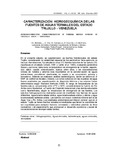Mostrar el registro sencillo del ítem
Caracterización hidrogeoquímica de las fuentes de aguas termales del estado Trujillo – Venezuela
| dc.rights.license | http://creativecommons.org/licenses/by-nc-sa/3.0/ve/ | |
| dc.contributor.author | Moreno, C. | |
| dc.contributor.author | Díaz, Juan Carlos | |
| dc.contributor.author | Caraballo, Héctor | |
| dc.contributor.author | Chacón, K. | |
| dc.contributor.author | Baptista, Gerardo | |
| dc.date.accessioned | 2009-03-17T21:55:04Z | |
| dc.date.available | 2009-03-17T21:55:04Z | |
| dc.date.issued | 2009-03-17T21:55:04Z | |
| dc.identifier.uri | http://www.saber.ula.ve/handle/123456789/27303 | |
| dc.description.abstract | En el presente estudio, se caracterizaron las fuentes hidrotermales del estado Trujillo, considerando la variabilidad espacial de los parámetros físico-químicos de las sus interrelaciones. Se estudiaron once (11) fuentes termales de las quince (15) reportadas en el estado (Urbani, 1991 y Carillo et al., 1995), evaluando parámetros físicos y químicos, tales como la temperatura de emergencia de la fuente, aspecto, olor, sabor, caudal, mineralización, dureza, entre otros, y las concentraciones iónicas de metales y aniones mas importantes en la caracterización de aguas subterráneas; permitiendo clasificarlas, en cuanto a su composición química y termalismo. Además se realizaron análisis bacteriológicos, donde se determinó el NMP de coliformes fecales y totales. Los iones metálicos en las muestras de agua fueron analizados por espectrometría de Absorción Atómica y los aniones fueron determinados según Standard Methods (1998). El rango de temperaturas de las fuentes estuvo comprendido entre 27ºC y 80ºC, considerándose la Fuente de Río Arriba como hipotermal, la Fuente de Chejendé mesotermal y las demás estudiadas como hipertermales, según la temperatura de emergencia de las fuentes. Los estudios hidrogeoquímicos realizados ponen de manifiesto tres familias de aguas diferentes: Agua bicarbonatada sódica, agua bicarbonatada sódica y cálcica y agua bicarbonatada sulfatada sódica. Las fuentes con mayor contenido mineral son la de Agua Viva y Río Arriba. Los resultados preliminares permitieron concluir que en el estado Trujillo se tienen fuentes termales mineralizadas que tienen la posibilidad de ser explotadas para consumo humano (envasado) y doméstico además de fines recreativos y de esparcimiento que promuevan el desarrollo económico y social de los sectores donde emergen estas fuentes. | es_VE |
| dc.language.iso | es | es_VE |
| dc.rights | info:eu-repo/semantics/openAccess | |
| dc.subject | Hidrogeoquímica | es_VE |
| dc.subject | Aguas termales | es_VE |
| dc.subject | Balneoterapia | es_VE |
| dc.subject | Aguas minerales | es_VE |
| dc.subject | Termalismo | es_VE |
| dc.title | Caracterización hidrogeoquímica de las fuentes de aguas termales del estado Trujillo – Venezuela | es_VE |
| dc.title.alternative | Hidrogeochemistry characterization of thermal waters sources of Trujillo state – Venezuela | es_VE |
| dc.type | info:eu-repo/semantics/article | |
| dc.description.abstract1 | In the present study, the sources characterized hydrothermal of the Trujillo state, considering the spatial variability of the parameters physical and chemical and your interrelationships. There were studied eleven (11) thermal springs of the fifteen (15) reported ones in the state (Urbani, 1991 and Carrillo, et al, 1995), evaluating physical and chemical, such parameters as the emergency temperature of the source, aspect, smell, flavor, wealth, mineralization, hardness between others and the ionic concentrations of metals and anions more importantly in the characterization of underground waters, allowing to classify them, as your chemical composition and thermals. In addition bacteriological analyses were realized, where the NMP decided of Coliformes fecal and total. The metallic ions in the water samples were analyzed by spectrometry of Atomic Absorption and the anions were determined according to Standard Methods (1998). The range of temperatures of the sources was included between 27ºC and 80ºC, being considered to be the source Río Arriba like hypothermal, the source of Chejendé mesothermal and other studied ones like hyperthermal, according to the emergency temperature of the sources. The studies hidrogeochemical realized reveal three families of different waters: It waters bicarbonate sodium, waters bicarbonate sodium and calcic and waters bicarbonate sulfate sodium. The sources with major mineral content are that of Agua Viva y Rio Arriba. The preliminary results allowed to conclude that in the Trujillo state thermal springs have minerals that have the possibility of being exploited for human and domestic consumption besides recreative purposes and scattering that promote the economic and social development of the sectors where they emerge these sources. | es_VE |
| dc.description.colacion | 92-105 | es_VE |
| dc.description.email | juand@ula.ve, jcdaz@hotmail.com | es_VE |
| dc.subject.dependencia | Biblioteca "Aquiles Nazoa" | es_VE |
| dc.subject.dependencia | Servicios Bibliotecarios de la Universidad de Los Andes (SERBIULA) | es_VE |
| dc.subject.facultad | Núcleo Rafael Rangel (NURR) | es_VE |
| dc.subject.keywords | Hidrogeochemistry | es_VE |
| dc.subject.keywords | Thermal waters | es_VE |
| dc.subject.keywords | Spatherapy | es_VE |
| dc.subject.keywords | Mineral waters | es_VE |
| dc.subject.keywords | Thermals | es_VE |
| dc.subject.publicacionelectronica | Academia | es_VE |
| dc.subject.thematiccategory | Artes y Humanidades | es_VE |
| dc.subject.tipo | Revistas | es_VE |
| dc.type.media | Texto | es_VE |
Ficheros en el ítem
Este ítem aparece en la(s) siguiente(s) colección(ones)
-
Academia - Año 06 - Nº 12
Julio - Diciembre 2007



